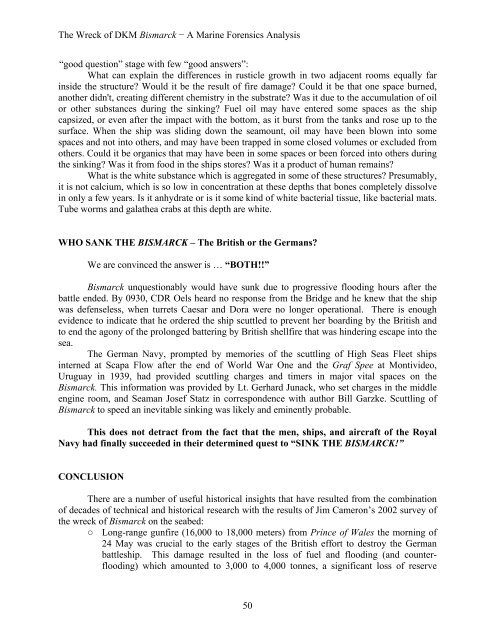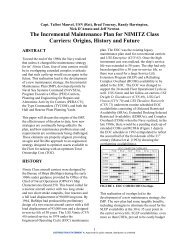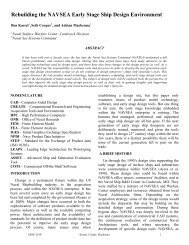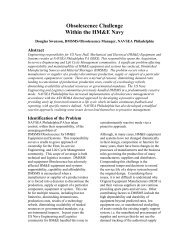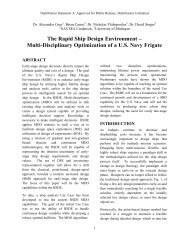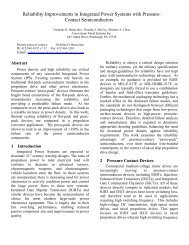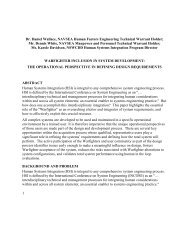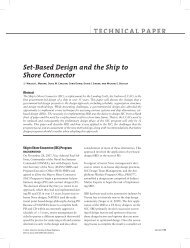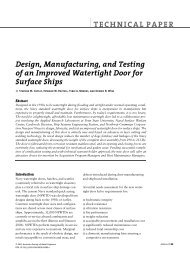The Wreck of DKM Bismarck − A Marine Forensics Analysis 1 The ...
The Wreck of DKM Bismarck − A Marine Forensics Analysis 1 The ...
The Wreck of DKM Bismarck − A Marine Forensics Analysis 1 The ...
You also want an ePaper? Increase the reach of your titles
YUMPU automatically turns print PDFs into web optimized ePapers that Google loves.
<strong>The</strong> <strong>Wreck</strong> <strong>of</strong> <strong>DKM</strong> <strong>Bismarck</strong> <strong>−</strong> A <strong>Marine</strong> <strong>Forensics</strong> <strong>Analysis</strong><br />
“good question” stage with few “good answers”:<br />
What can explain the differences in rusticle growth in two adjacent rooms equally far<br />
inside the structure? Would it be the result <strong>of</strong> fire damage? Could it be that one space burned,<br />
another didn't, creating different chemistry in the substrate? Was it due to the accumulation <strong>of</strong> oil<br />
or other substances during the sinking? Fuel oil may have entered some spaces as the ship<br />
capsized, or even after the impact with the bottom, as it burst from the tanks and rose up to the<br />
surface. When the ship was sliding down the seamount, oil may have been blown into some<br />
spaces and not into others, and may have been trapped in some closed volumes or excluded from<br />
others. Could it be organics that may have been in some spaces or been forced into others during<br />
the sinking? Was it from food in the ships stores? Was it a product <strong>of</strong> human remains?<br />
What is the white substance which is aggregated in some <strong>of</strong> these structures? Presumably,<br />
it is not calcium, which is so low in concentration at these depths that bones completely dissolve<br />
in only a few years. Is it anhydrate or is it some kind <strong>of</strong> white bacterial tissue, like bacterial mats.<br />
Tube worms and galathea crabs at this depth are white.<br />
WHO SANK THE BISMARCK – <strong>The</strong> British or the Germans?<br />
We are convinced the answer is … “BOTH!!”<br />
<strong>Bismarck</strong> unquestionably would have sunk due to progressive flooding hours after the<br />
battle ended. By 0930, CDR Oels heard no response from the Bridge and he knew that the ship<br />
was defenseless, when turrets Caesar and Dora were no longer operational. <strong>The</strong>re is enough<br />
evidence to indicate that he ordered the ship scuttled to prevent her boarding by the British and<br />
to end the agony <strong>of</strong> the prolonged battering by British shellfire that was hindering escape into the<br />
sea.<br />
<strong>The</strong> German Navy, prompted by memories <strong>of</strong> the scuttling <strong>of</strong> High Seas Fleet ships<br />
interned at Scapa Flow after the end <strong>of</strong> World War One and the Graf Spee at Montivideo,<br />
Uruguay in 1939, had provided scuttling charges and timers in major vital spaces on the<br />
<strong>Bismarck</strong>. This information was provided by Lt. Gerhard Junack, who set charges in the middle<br />
engine room, and Seaman Josef Statz in correspondence with author Bill Garzke. Scuttling <strong>of</strong><br />
<strong>Bismarck</strong> to speed an inevitable sinking was likely and eminently probable.<br />
This does not detract from the fact that the men, ships, and aircraft <strong>of</strong> the Royal<br />
Navy had finally succeeded in their determined quest to “SINK THE BISMARCK!”<br />
CONCLUSION<br />
<strong>The</strong>re are a number <strong>of</strong> useful historical insights that have resulted from the combination<br />
<strong>of</strong> decades <strong>of</strong> technical and historical research with the results <strong>of</strong> Jim Cameron’s 2002 survey <strong>of</strong><br />
the wreck <strong>of</strong> <strong>Bismarck</strong> on the seabed:<br />
○ Long-range gunfire (16,000 to 18,000 meters) from Prince <strong>of</strong> Wales the morning <strong>of</strong><br />
24 May was crucial to the early stages <strong>of</strong> the British effort to destroy the German<br />
battleship. This damage resulted in the loss <strong>of</strong> fuel and flooding (and counterflooding)<br />
which amounted to 3,000 to 4,000 tonnes, a significant loss <strong>of</strong> reserve<br />
50


